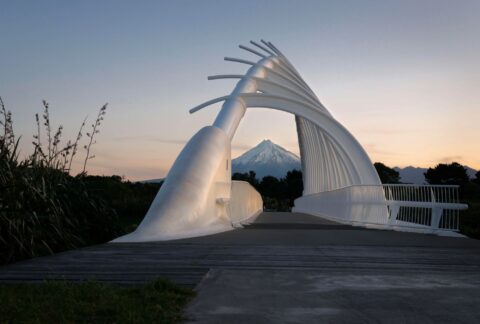Make a stylish, sustainable statement in your bathroom with artistic fittings and water-saving features.
Reuse and Recycle
Our bathroom had recently been renovated when we moved into our house, so even though it’s not the most exciting space, there’s no need to change it. However, we are planning to add a bath and an extra toilet when we build our extension.
To keep our manufacturing footprint down, we’re looking at getting these items second-hand. There are plenty of options on Trade Me or at salvage yards, from modern, hardly used tubs to antique claw-foot baths and even retro pink numbers. There are also second-hand vanities, taps, showers, tiles and anything else you may need for a bathroom reno.
Searching in Trade Me’s used-toilet category makes me feel a bit squeamish, but then I remember that most of the homes I’ve lived in have featured porcelain thrones used by former residents. The main issue with buying second-hand is the logistics of removal and relocation. If you do buy a second-hand toilet, opt for a water-efficient newer model (see tips below).
Material World
From flooring to tiles, tapware and cabinetry, choosing recycled, repurposed or sustainably sourced materials will help your reno to be more eco-friendly. Vanities can be purchased second-hand or even made from repurposed dressers, cabinets and more.
If buying new, consider Forest Stewardship Council (FSC)-certified wood or Ecoply, made from sustainably grown New Zealand pine. Other plywood and MDF can off-gas formaldehyde, so choose products with a low formaldehyde-emission rating.
When looking for tiles or vanity countertops, recycled materials are worth investing in. The resurgence of terrazzo over the last few years has brought this timeless look back into the limelight.
New Zealand company Giacon Terrazzo makes a range of tiles, flooring and precast items from recycled and natural materials – glass, marble, aggregates and even oyster shells. Director Andrew Giacon’s family have been making terrazzo in New Zealand for 100 years – his grandfathers provided much of the terrazzo used in the rebuild of Napier after the 1931 earthquake.

The company has this year been awarded an Auckland Council grant to recycle and reuse scrap material from marble and granite fabricators. If a customer has a particular colour in mind, Giacon can source offcuts. They can also recycle marble removed in a customer’s renovation, or use the client’s own shells and stones.
Bold Bathroomware
Franklins, which imports European bathroomware, has a number of brands boasting sustainability credentials, artistic touches and water-saving features, including Bette, Vitra, Schell and Hansa. Manufactured in Germany using glazed titanium steel, Bette’s baths, basins and shower trays are recyclable and made without chemicals or solvents.
For something that makes a statement, Australian brand Apaiser is known for sustainable luxury, with geometric designs providing a point of difference. Its baths, vanities, basins and shower trays are made in Indonesia and Thailand from up to 90 percent reclaimed, crushed marble. The brand is also known for its collaborations with the likes of British interior designer Kelly Hoppen and Singapore-based design brand Wohabeing.
For New Zealand-made baths, vanities and more, look up Bath Co, which stocks ranges including VCBC and Michel César, with the latter’s products using FSC-certified timber from Aotearoa. Primo is another company that makes bathroomware in New Zealand, from sustainably sourced local timber.
Liquid Saving Assets
Go With The Low-flow
Completely waterless, a composting toilet is the most sustainable option for the smallest room in the house. Unfortunately, while these are ideal for off-the-grid homes, they’re not legal for most urban homes. Under the Building Code, if your property is connected to a mains sewer, you must use the sewerage system unless the building consent authority provides a waiver. Also, because of the risks associated with inadequate maintenance, the Ministry of Health does not recommend waterless toilets in urban areas.
The next best option is to buy a low-flow toilet with a dual flush to minimise water usage – most new toilets should be compliant but check the water-efficiency label to be sure.
Power Down
Water-efficient showerheads and taps are also good ways to minimise water usage. If you don’t want to buy new fittings, aerators can be added to existing taps and showerheads to reduce the flow rate by around 50 percent.
Hot Topic
Traditional hot-water cylinders waste energy keeping things hot. The government’s Smarter Homes website says solar water heating is the best alternative, followed by a heat pump hot-water system, then wetback water heaters and instant gas.
Solar water heating isn’t cheap, but the organisation says that a well-installed system should be able to deliver up to 75 percent of your hot water heating needs over the year (in most parts of the country).
Serious Savings
Installing a grey-water reuse system that diverts shower, bath and basin water to your garden or toilet cistern instead of sending it down the plughole is a great way to save water. However, you need to get building consent to do this, have the system properly installed and maintained, and be mindful that there could still be bacteria in the water. If used in the garden, water should be discharged under the soil, not on top, and you should not use it on areas where food grows.








